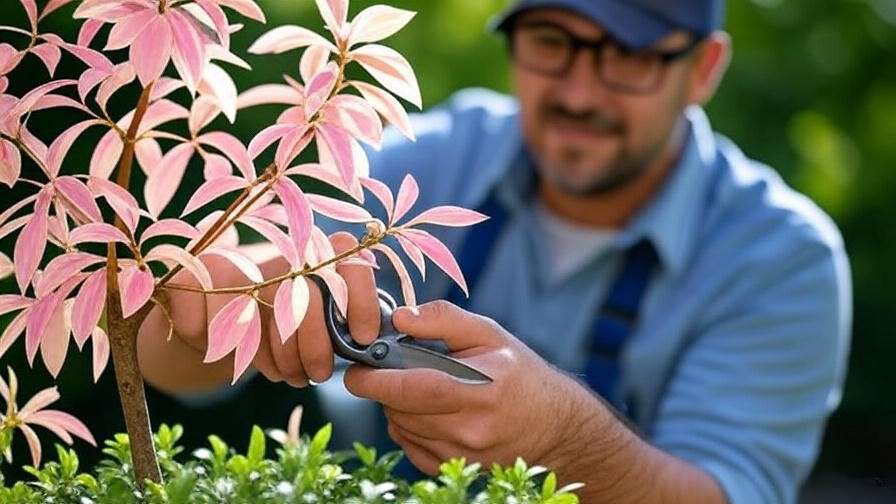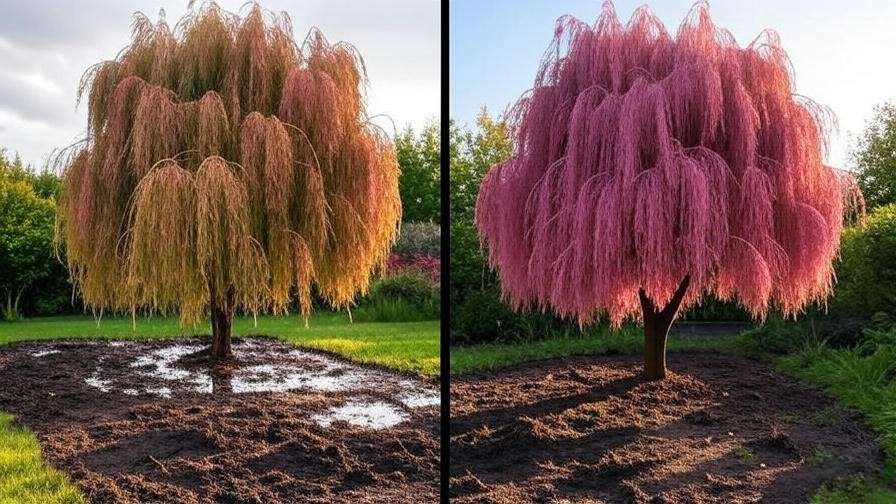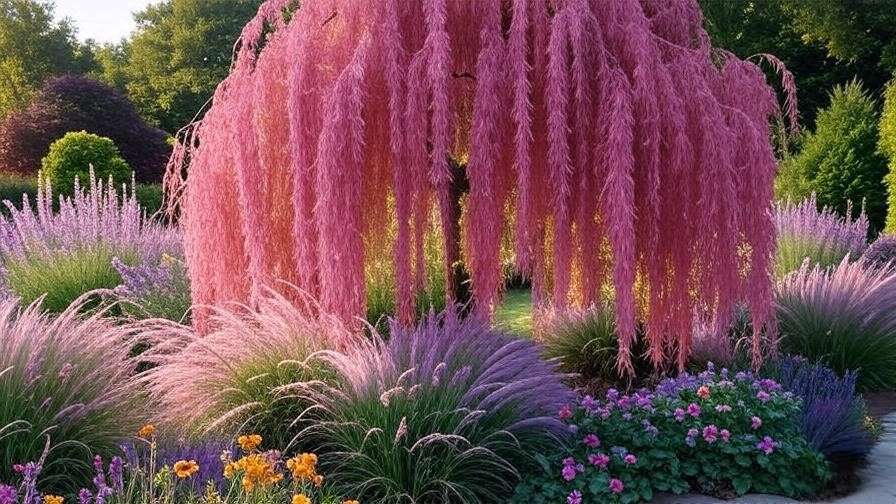Picture this: a cascade of delicate pink foliage swaying gently in the breeze, transforming your garden into a dreamy, vibrant oasis. The Willow Tree Pink is a showstopper, captivating gardeners with its unique coloration and graceful weeping form. Whether you’re a novice or a seasoned plant enthusiast, mastering the care of a Willow Tree Pink can elevate your landscape to new heights. In this comprehensive guide, we’ll unlock the secrets to nurturing this ornamental gem, ensuring vibrant growth and stunning color year-round. From planting to pest control, we’ve got you covered with expert-backed tips to make your Willow Tree Pink thrive. 🌸
This article dives deep into actionable care strategies, addressing common challenges and offering solutions to keep your tree healthy and beautiful. Expect practical advice, troubleshooting tips, and design ideas to make your Willow Tree Pink the star of your garden. Let’s get started! 🌱
1. Understanding the Willow Tree Pink: A Unique Ornamental Gem 🌸
1.1 What Is the Willow Tree Pink?
The Willow Tree Pink, often a cultivar of Salix (willow) species like Salix integra ‘Hakuro Nishiki,’ is renowned for its striking pink and cream-variegated foliage. Native to East Asia, this deciduous shrub or small tree features slender, arching branches that create a weeping effect, making it a favorite in ornamental gardens. Its leaves emerge with vibrant pink hues in spring, transitioning to a mix of green, white, and pink as the season progresses. Typically growing to 6–10 feet tall, it’s perfect for small gardens or as a focal point in larger landscapes. 🌿
1.2 Benefits of Growing a Willow Tree Pink
Beyond its aesthetic appeal, the Willow Tree Pink offers multiple benefits:
- Visual Impact: Its pink-tinted foliage adds a pop of color, complementing any garden style.
- Environmental Perks: Provides shade, stabilizes soil, and supports local pollinators.
- Emotional Resonance: Symbolizing grace and resilience, it brings a serene vibe to outdoor spaces.
This tree’s versatility makes it ideal for everything from Zen gardens to modern landscapes. 🌼
1.3 Common Misconceptions About Willow Tree Pink Care
Many gardeners shy away from the Willow Tree Pink, fearing it’s too delicate or high-maintenance. In truth, with proper care, this tree is surprisingly resilient. Another myth is that its pink color requires complex upkeep—false! Simple, consistent care ensures its vibrancy. This guide will debunk these myths with practical, expert advice. 🌳
2. Planting Your Willow Tree Pink: Setting the Foundation for Success 🌱
2.1 Choosing the Right Location
To thrive, your Willow Tree Pink needs the right environment:
- Climate: Best suited for USDA hardiness zones 5–7, though it can adapt to slightly warmer or cooler climates with care.
- Sunlight: Prefers full sun (6+ hours daily) for vibrant pink foliage, but tolerates partial shade in hotter regions.
- Soil: Thrives in well-draining, loamy soil with a pH of 5.5–7.5. Avoid heavy clay or waterlogged areas to prevent root issues.
Choosing a spot with good air circulation also reduces disease risk. 🌞
2.2 Preparing the Soil
Healthy soil is the backbone of a thriving Willow Tree Pink. Follow these steps:
- Test the Soil: Use a soil testing kit to check pH and nutrient levels. Aim for slightly acidic to neutral soil.
- Amend as Needed: Mix in organic matter like compost or aged manure to improve drainage and fertility.
- Ensure Drainage: If your soil is clay-heavy, add sand or perlite to prevent waterlogging.
A well-prepared soil bed sets your tree up for robust growth. 🌾
2.3 Planting Tips for Beginners
- Timing: Plant in early spring or fall for optimal root establishment. Avoid extreme heat or frost.
- Depth and Spacing: Dig a hole twice as wide and as deep as the root ball. Space trees 6–8 feet apart to accommodate their mature spread.
- Initial Watering: Water deeply after planting, ensuring the soil stays moist (but not soggy) for the first few weeks.
Expert Tip: Create a watering ring around the base to direct water to the roots. Check out this beginner’s planting checklist for a foolproof start. 🌱
3. Essential Care Practices for a Thriving Willow Tree Pink 🌳
3.1 Watering Needs
Proper watering is critical, especially during the first year:
- Establishment Phase: Water 2–3 times per week, providing 1–2 inches of water. Use a soaker hose for deep, even moisture.
- Mature Trees: Reduce to weekly watering, adjusting for rainfall. Aim for consistently moist soil without waterlogging.
- Signs of Trouble: Yellowing leaves may indicate overwatering; drooping foliage suggests underwatering. Adjust accordingly.
In hotter climates, mulch around the base to retain moisture. 💧
3.2 Fertilizing for Vibrant Color
To enhance the Willow Tree Pink’s signature hues:
- Fertilizer Type: Use a balanced 10-10-10 NPK fertilizer or a slow-release granular option in early spring.
- Frequency: Fertilize once in spring and again in mid-summer for young trees. Mature trees may need only annual feeding.
- Organic Options: Compost tea or fish emulsion works well for eco-conscious gardeners.
Avoid over-fertilizing, which can lead to excessive green growth at the expense of pink foliage. 🌸
Pro Tip: Test soil annually to avoid nutrient imbalances.
3.3 Pruning for Shape and Health
Pruning keeps your Willow Tree Pink shapely and healthy:
- When to Prune: Late winter or early spring, before new growth begins.
- How to Prune: Use clean, sharp shears to remove dead, damaged, or crossing branches. Shape the canopy to maintain its weeping form.
- Avoid Common Mistakes: Over-pruning can stress the tree, while neglecting pruning can lead to a tangled, unhealthy structure.
Case Study: Sarah, a gardener in Oregon, transformed her overgrown Willow Tree Pink into a stunning focal point by following a simple pruning schedule. Her tip? “Prune lightly but regularly for the best shape.” ✂️

4. Protecting Your Willow Tree Pink from Pests and Diseases 🐞
4.1 Common Pests to Watch For
The Willow Tree Pink can attract pests like:
- Aphids: Small sap-sucking insects causing curled leaves. Control with neem oil or insecticidal soap.
- Scale: Hard, immobile pests on stems. Remove with a soft brush or apply horticultural oil.
- Willow Borers: Larvae that tunnel into branches. Prune affected areas and use targeted insecticides if severe.
Regular inspections catch infestations early. 🕵️♀️
4.2 Preventing and Treating Diseases
Common diseases include:
- Root Rot: Caused by overwatering or poor drainage. Ensure proper soil prep and avoid waterlogging.
- Powdery Mildew: White coating on leaves, treatable with fungicides or improved air circulation.
- Leaf Spot: Dark spots on foliage. Remove affected leaves and apply a copper-based fungicide.
Proactive care, like mulching and proper spacing, minimizes disease risk. 🌿
Expert Insight: Dr. Jane Ellis, a horticulturist, emphasizes, “Regular monitoring and early intervention are key to keeping your Willow Tree Pink disease-free.”
4.3 Seasonal Care Adjustments
Protecting your Willow Tree Pink through changing seasons is crucial:
- Winter: Apply a 2–3 inch layer of organic mulch (e.g., bark or wood chips) around the base to insulate roots against frost. Wrap young trees in burlap in colder climates to shield from harsh winds.
- Summer: Increase watering during heatwaves, ensuring soil stays moist but not soggy. Check for signs of heat stress, like wilting leaves.
- Fall: Rake fallen leaves to prevent fungal growth and inspect for pests before dormancy.
Pro Tip: Use a rain gauge to monitor water levels during rainy seasons to avoid overwatering. 🌦️

5. Troubleshooting Common Willow Tree Pink Problems 🛠️
5.1 Why Is My Willow Tree Pink Losing Its Color?
The vibrant pink foliage is the hallmark of this tree, so fading color can be disheartening. Common causes include:
- Nutrient Deficiency: Lack of nitrogen or iron can dull foliage. Apply a balanced fertilizer or chelated iron supplement as needed.
- Insufficient Sunlight: Less than 6 hours of sun may reduce pink hues. Consider relocating container-grown trees or trimming nearby shade sources.
- Stress: Overwatering, poor drainage, or compacted soil can stress the tree. Test soil and adjust care routines.
Solution: Conduct a soil test, ensure proper sunlight, and fertilize in early spring to restore vibrancy. 🌸

5.2 Addressing Slow Growth or Wilting
Slow growth or wilting signals underlying issues:
- Root Health: Compacted or waterlogged roots hinder growth. Aerate soil around the base using a garden fork, and ensure proper drainage.
- Watering Issues: Inconsistent watering can cause wilting. Stick to a regular schedule, checking soil moisture with a finger test (1 inch deep).
- Nutrient Shortages: Slow growth may indicate low nutrients. Apply a slow-release fertilizer and monitor progress.
Expert Tip: Use a moisture meter for precise watering, especially for young trees. 🌱
5.3 Dealing with Invasive Roots
Willow trees, including the Pink variety, are known for aggressive root systems:
- Prevent Damage: Plant at least 15–20 feet from structures, pipes, or sidewalks to avoid root intrusion.
- Root Barriers: Install physical barriers (e.g., plastic or metal sheets) 18–24 inches deep during planting to control root spread.
- Regular Maintenance: Prune roots cautiously if they encroach on other plants, but consult an arborist for major issues.
Visual Idea: Include a table comparing root management strategies for willows vs. other ornamental trees. 🌳
6. Enhancing Your Garden with Willow Tree Pink: Design Ideas 🌼
6.1 Companion Planting
Pairing your Willow Tree Pink with complementary plants enhances its beauty:
- Ornamental Grasses: Feather reed grass or blue fescue contrasts beautifully with pink foliage.
- Flowering Shrubs: Lavender or hydrangeas add color and texture without competing for resources.
- Ground Covers: Creeping thyme or sedum provides low-maintenance coverage around the base.
Choose plants with similar water and sunlight needs to create a cohesive garden. 🌷

6.2 Using Willow Tree Pink as a Focal Point
The Willow Tree Pink’s weeping form makes it a natural centerpiece:
- Small Gardens: Plant in a raised bed or container to highlight its cascading branches.
- Large Landscapes: Use as a standalone feature near a pond or pathway for dramatic effect.
- Seasonal Displays: Surround with seasonal blooms like tulips in spring or chrysanthemums in fall to accentuate its pink hues.
Design Tip: Add solar-powered garden lights to illuminate the tree at night for a magical glow. ✨

6.3 Eco-Friendly Landscaping Benefits
The Willow Tree Pink supports sustainable gardening:
- Wildlife Support: Its dense foliage provides shelter for birds and pollinators.
- Erosion Control: Strong roots stabilize soil on slopes or near water bodies.
- Low Maintenance: With proper care, it requires minimal intervention, reducing water and chemical use.
Incorporate native plants around your Willow Tree Pink to boost biodiversity. 🌿
7. Expert Tips for Long-Term Success with Willow Tree Pink 🌟
- Seasonal Maintenance Calendar:
- Spring: Fertilize, prune lightly, and check for pests.
- Summer: Monitor watering and mulch to retain moisture.
- Fall: Clear debris and prepare for dormancy.
- Winter: Insulate roots and protect young trees from frost.
- Propagation: Take softwood cuttings in early summer, dip in rooting hormone, and plant in moist soil for new trees.
- Climate Adaptation: In hot climates, provide afternoon shade; in colder regions, use windbreaks to protect young trees.
- Arborist Advice: Regular professional inspections every 2–3 years ensure long-term health, especially for mature trees.
Expert Quote: “Consistency is key. A little care each season keeps your Willow Tree Pink thriving for decades,” says arborist Mark Thompson. 🌳
8. Frequently Asked Questions (FAQs) ❓
- Q1: How fast does a Willow Tree Pink grow?
A: It grows moderately fast, about 1–2 feet per year under ideal conditions, reaching maturity in 5–7 years. - Q2: Can I grow a Willow Tree Pink in a container?
A: Yes, use a large container (20+ gallons) with excellent drainage and repot every 2–3 years. - Q3: What causes yellowing leaves, and how can I fix it?
A: Yellowing often stems from overwatering or nutrient deficiency. Check soil moisture and apply a balanced fertilizer. - Q4: Is the Willow Tree Pink safe for pets or children?
A: Generally safe, but its leaves may cause mild stomach upset if ingested. Keep away from curious pets or kids. - Q5: How do I propagate a Willow Tree Pink?
A: Take 6-inch cuttings in summer, treat with rooting hormone, and plant in moist, well-draining soil.
9. Conclusion: Your Path to a Stunning Willow Tree Pink 🌸
Caring for a Willow Tree Pink is a rewarding journey that transforms your garden into a vibrant, elegant haven. By following this guide—planting in the right spot, maintaining consistent care, and addressing challenges promptly—you’ll enjoy its stunning pink foliage and graceful form for years to come. Whether you’re troubleshooting fading leaves or designing a show-stopping landscape, these expert tips empower you to succeed. Start today, and let your Willow Tree Pink shine! 🌿
Have a Willow Tree Pink success story or question? Share in the comments below, and explore our related articles on ornamental tree care or eco-friendly landscaping for more inspiration. Happy gardening! 🌷













